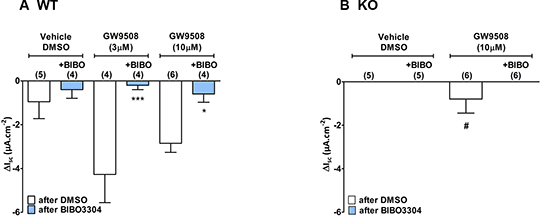Endogenous peptide YY and Y1 receptors mediate FFA1 responses in mouse colon mucosa Long chain free fatty acids (FFAs) exhibit affinity for the FFA1 receptor and these nutrients are thought to have a physiological role in modulating energy homeostasis, in part by activating this receptor (which is also known as GPR40) [1]. FFAs trigger the secretion of peptide YY (PYY) and glucagon-like peptide-1 (GLP-1) from enteroendocrine L cells [2] and FFA1 is highly expressed in these incretin-secreting cells [3] as well as insulin-secreting pancreatic β cells [4]. Here we set out to establish the involvement of endogenous PYY and Y1 receptors in FFA1 activation using the FFA1 agonist GW9508 [5], the Y1 antagonist BIBO3304, in intact descending colon mucosa from wild-type (WT) and PYY-/- (KO) mice. Changes in short circuit current (ΔISC) were measured under voltage-clamp conditions (see [6]). Mucosae from WT or KO mice were pre-treated with BIBO3304 (300nM) or vehicle (0.01% DMSO, basolaterally) and responses (in µA.cm-2) to apical GW9508 (3 or 10µM) were recorded. Statistically significant differences (P ≤ 0.05) were identified using one-way ANOVA with Bonferroni’s post-test. BIBO3304 revealed significant PYY-Y1 tone in WT mucosa (5.6 ± 1.1 µA.cm-2, n=12) but not in KO tissue (0.9 ± 0.3 µA.cm-2, n=11, P < 0.001). In WT tissue, GW9508 reduced ISC in a BIBO3304-sensitive manner (Fig 1A) while BIBO3304 abolished residual GW9508 responses in KO colon (Fig 1B).
Fig 1: The effect of GW9508 ± BIBO3304 in WT (A) or PYY KO (B) mouse colon mucosa. Values are the mean -1SEM, * P ≤ 0.05; ** P ≤ 0.01 vs vehicle controls. # indicates P ≤ 0.05 comparing WT vs KO data. Apical GW9508 stimulated endogenous PYY release and Y1 receptor activation resulting in reductions in ISC in WT, but not in KO colon. Y1 tone was also absent from KO tissue. We conclude that luminal colonic FFA1 activation triggers PYY-Y1 receptor paracrine inhibitory epithelial responses and suggest that this peptide may also contribute to slower intestinal transit [7] and to satiety. The FFA1 receptor is already a therapeutic target for Type 2 diabetes and obesity [8] and the agonist, TAK-875 is currently in phase 3 anti-diabetic trials. The co-release of PYY with GLP-1 should contribute to FFA1 agonist efficacy. [1] Holliday ND et al. (2012) Front Endocrinol 2:112 [2] Habib AM et al. (2013) Diabetologia 56:1413 [3] Edfalk S et al. (2008) Diabetes 57:2280 [4] Itoh Y et al. (2003) Nature 422:173 [5] Briscoe CP et al. (2006) Br J Pharmacol 148:619 [6] Cox HM et al. (2010) Cell Metab 11:532 [7] Tough IR et al. (2011) Br J Pharmacol 164:471 [8] Ito R et al. (2013) Br J Pharmacol 170:568
|


